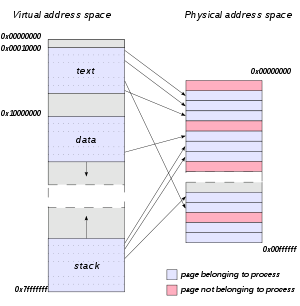
Back مساحة من العناوين الافتراضية Arabic Espai d'adreces virtuals Catalan Virtueller Adressraum German Espacio de direcciones virtuales Spanish Adresse virtuelle French Prividna adresa Croatian 가상 주소 공간 Korean เวอชวลแอดเดรสสเปซ Thai 虚拟地址 Chinese
This article has multiple issues. Please help improve it or discuss these issues on the talk page. (Learn how and when to remove these template messages)
|

In computing, a virtual address space (VAS) or address space is the set of ranges of virtual addresses that an operating system makes available to a process.[1] The range of virtual addresses usually starts at a low address and can extend to the highest address allowed by the computer's instruction set architecture and supported by the operating system's pointer size implementation, which can be 4 bytes for 32-bit or 8 bytes for 64-bit OS versions. This provides several benefits, one of which is security through process isolation assuming each process is given a separate address space.
- ^ IBM Corporation. "What is an address space?". Retrieved August 24, 2013.
© MMXXIII Rich X Search. We shall prevail. All rights reserved. Rich X Search